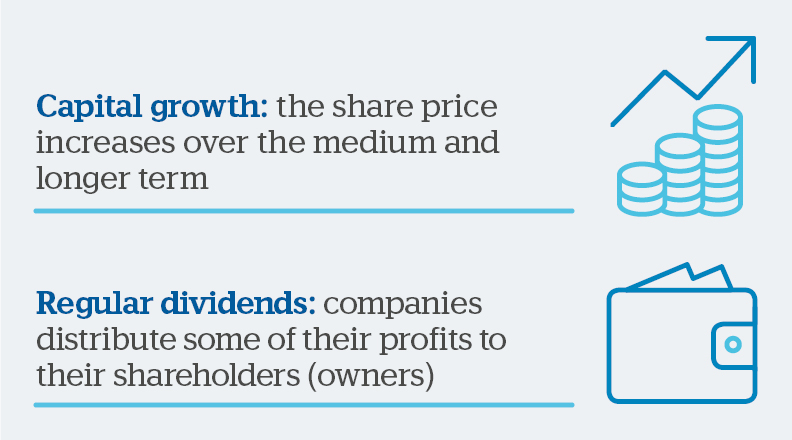Shares – also known as equities or stocks – are one of the most well known types of financial assets. What do you need to know?
What are shares?
Shares represent partial ownership in companies traded (‘listed’) on stock exchanges. Some of these shares will belong to businesses that are familiar household names, but others will belong to businesses with a much lower profile.
The regulatory requirements for listing a company are extensive. For example, in the UK, this includes:
- Supplying three years of audited historic information
- Having an expected minimum market value following the listing
- 25% of the shares must be in public hands
Once listed on a stock exchange, public companies have more extensive legal and regulatory obligations than as private companies.
Why do businesses sell shares?
Privately owned businesses often decide to list on stock exchanges (‘to go public’) because their owners wish to diversify their wealth. They will receive cash for crystallising part of their existing holdings.
Another major reason for going public is to source additional funding to expand business operations, perhaps by purchasing another company.
When did companies begin selling shares?
The first company to offer shares to the public was the Dutch East India Company, which began trading in 1602 on the Amsterdam Stock Exchange. It was the only quoted company until the listing of the West India Company on the same exchange in 1623.

Why do shares prices rise and fall?
Stock markets are changeable by nature. If you hear that a stock market has risen, this means that the overall value of shares in that market has gone up. If you hear that the market has fallen, the overall value of its shares has dropped.
There are many factors that can trigger good or bad share price performance. These can be roughly classified into three groups:
A company’s individual financial performance and outlook
The demand for shares, as well as their liquidity (the number of shares available for purchase or sale)
The mood among investors – this could mean a positive or negative view of stock markets in general, or of the shares in a specific company or industry. In itself, market sentiment can be affected by a range of influences, from economic news to changes in government regulation.
How do investors make money from shares?
Shares are the best performing mainstream financial asset over the long term, both in the UK and globally.
Always keep in mind that past performance is no guarantee of future returns.
But despite their long track record of returns, share prices are volatile. This means that there are opportunities to make money, but also to lose it. There’s no guarantee that investors will make money from shares, or any other type of financial asset.
Making financial gains through investing in shares requires contributions from at least one of the following sources:

Remember, it's never certain that investing in a stock will lead to either capital growth or dividend returns.
It's also worth noting that not all companies pay a dividend, and certain sectors (for example technology) are associated with very low (or entirely absent) dividend payouts. In contrast, utility companies are often linked with high dividend payouts.
How does Handelsbanken Wealth and Asset Management invest in shares?
There are two main methods by which we can purchase shares for our investment strategies:
Sometimes we buy shares directly on a stock exchange, either in the UK or overseas
More commonly, we purchase units in collective investments operated by another investment manager.
Collective investments may be focused on a sector, geography or investment theme, or even replicate the performance of a particular market index. There can be cost or accessibility advantages to this approach over directly investing ourselves, especially in markets that are more difficult to access and require a high level of local knowledge. However, we will only take this approach if it's the best way of achieving our investment goals.
When we're choosing assets for our investment strategies, we can opt for products which use one of two different approaches to investing:
These are tracker products – aiming to replicate the performance of a given index. That could be a national level index, like the UK’s FTSE 100, or an industry index, like the US healthcare sector. Passive products tend to have cheaper fees, reflecting their relatively automated nature.
These products rely on manager skill, with the investment manager choosing specific investments based on prospects, performance and other key characteristics. Active products tend to have higher fees, reflecting the additional skill and labour involved in their creation and management.
Is it risky to invest in shares?
All forms of investing incur some risk. Even just holding on to your wealth in cash exposes you to some risks, as the value of cash can be eroded by inflation. However, shares are certainly classed as a high risk type of asset.
The level of risk associated with a particular asset is typically linked to the return that it could achieve, creating a tradeoff between risk and potential reward.
Investors will want to be rewarded for their willingness to invest in more risky investments such as shares, compared to more cautious investors who prefer lower risk assets such as bonds and cash. As a result, in the good times, they expect to be rewarded more handsomely (through share price gains or generous dividends). In the bad times, when markets are down, they are more likely to see price falls and dividend cuts.
If you’d like to find out more about the right level of risk for you, a member of our experienced team would be happy to help.
Can I invest in shares alongside other asset types?
Yes, and in fact we would recommend this approach for most investors.
Diversification should be an important consideration when building an investment portfolio for the long term.
One way to achieve this is by a mix of different assets including shares, bonds and alternative assets. Their performance will likely be uncorrelated and can help to generate the desired level of financial returns. Taking a blended approach in this way is often called ‘multi asset investing’.
If you’d like to find out more about multi asset investing, please continue to explore our Learning Zone, where we have more resources on this topic.
Important Information
Handelsbanken Wealth & Asset Management Limited is authorised and regulated by the Financial Conduct Authority (FCA) in the conduct of investment and protection business, and is a wholly-owned subsidiary of Handelsbanken plc. For further information on our investment services go to wealthandasset.handelsbanken.co.uk/important-information. Tax advice which does not contain any investment element is not regulated by the FCA. Professional advice should be taken before any course of action is pursued.
- Find out more about our services by contacting us on 01892 701803 or exploring the rest of our website: wealthandasset.handelsbanken.co.uk
- Read about how our investment services are regulated, and other important information: wealthandasset.handelsbanken.co.uk/important-information
- Learn more about wealth and investment concepts in our Learning Zone: wealthandasset.handelsbanken.co.uk/learning-zone/
- Understand more about the language and terminology used in the financial services industry and our own publications through our Glossary of Terms: wealthandasset.handelsbanken.co.uk/glossary-of-terms/
All commentary and data is valid, to the best of our knowledge, at the time of publication. This document is not intended to be a definitive analysis of financial or other markets and does not constitute any recommendation to buy, sell or otherwise trade in any of the investments mentioned. The value of any investment and income from it is not guaranteed and can fall as well as rise, so your capital is at risk.
We manage our investment strategies in accordance with pre-defined risk objectives, which vary depending on the strategy’s risk profile.
Portfolios may include individual investments in structured products, foreign currencies and funds (including funds not regulated by the FCA) which may individually have a relatively high risk profile. The portfolios may specifically include hedge funds, property funds, private equity funds and other funds which may have limited liquidity. Changes in exchange rates between currencies can cause investments of income to go down or up.
Registered Head Office: 25 Basinghall Street, London EC2V 5HA. Registered in England No: 4132340